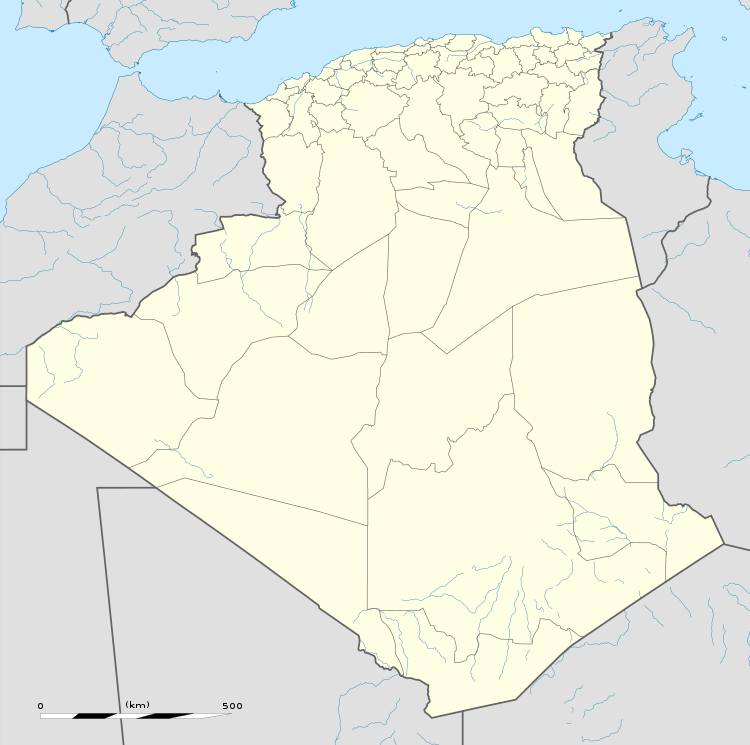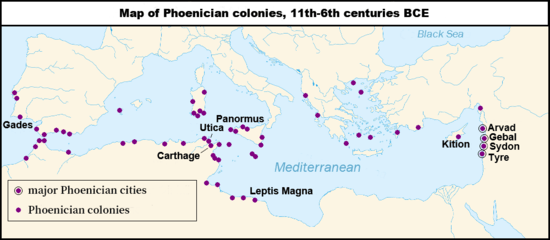Iomnium
Iomnium was a Phoenician, Carthaginian, and Roman port on Algeria's Mediterranean coast at the site of present-day Tigzirt.
 Shown within Algeria | |
| Location | Tigzirt, Tizi Ouzou Province, Algeria |
|---|---|
| Coordinates | 36°53′35″N 4°07′24″E |
Name
Iomnium is a latinization of the town's Punic name, which appears to have combined the elements ʾY (Punic: 𐤀𐤉) and ʾMN (𐤀𐤌𐤍), meaning "Strong Island"[1] or "Peninsula of Strength".[2] The same triliteral root can also mean "craftsman", "artisan", &c.[3]
Geography
Iomnium was located on a peninsula, with the civic buildings located at the end of its cape.
History
The town was established as a colony on the trade route between Phoenicia and the Strait of Gibraltar. It formed part of the Carthaginian Empire and served as the harbor for the fortress at Rusippisir (present-day Taksebt) 3 km (2 mi) to its east.[1]
It fell under Roman hegemony following the Punic Wars. Under Roman rule, Iomnium had the status of a native city (civitas)[4] in the province of Numidia. Excavation has revealed a moderately-sized Roman emporium.[5] It had a forum, temple, courthouse, and magistrates' office. Its Roman streets were laid out on a grid.[6] A public bath and ornamental mosaic have been found, with inscriptions and statues scattered around.[7]
It was conquered with the rest of the area around it during the late 7th century.
Identification of its ruins were long delayed by errors in its mention in the Tabula Peutingeriana,[8] which placed it "42 miles" west of Rusippisir instead of the actual distance of about 2 miles.[1] Iomnium, not Iol, is also probably the Ioulíou (Greek: Ἰουλίου) mentioned by the Periplus of Pseudo-Scylax, the present text probably representing a scribal error of the original name.[1]
Religion
Iomnium was the seat of a Christian bishopric in antiquity.[9] The ruins of a small basilica have been uncovered.[10] The building has three naves with galleries over the aisles. There was a baptistery of polyfoil plan to the northeast.
The diocese was revived by the Roman Catholic Church as a titular see.[11] The current bishop is Jaime Calderón Calderón.
References
Citations
- Lipiński (2004), pp. 397–9.
- P Siggers, Vestiges toponymiques de la presence phenico punique en Sardaigne, p25–35.
- Watson (2013), p. 328.
- Robert A. Kaster, Guardians of Language: The Grammarian and Society in Late Antiquity (University of California Press, 1997). p352 & 466.
- Photos of Iomnium.
- Richard Stillwell, The Princeton Encyclopedia of Classical Sites (Princeton University Press, 2017) p414.
- Richard Stillwell, William L. MacDonald, Marian Holland McAllister, Stillwell, Richard, MacDonald, William L., McAlister, Marian Holland, Ed., The Princeton]] Encyclopedia of Classical Sites IOMNIUM.
- Mannert & al. (1842), p. 490.
- Iomnium.
- Iomnium.
- Titular Episcopal See of Iomnium.
Bibliography
- Lipiński, Edward (2004), Itineraria Phoenicia, Orientalia Lovaniensia Analecta, No. 127, Studia Phoenicia, Vol. XVIII, Leuven: Uitgeverij Peeters.
- Mannert, Conrad; et al. (1842), Géographie Ancienne des États Barbaresques.... (in French)
- Watson, Wilfred G.E. (2013), "Loanwords in Phoenician and Punic", Ritual, Religion, and Reason, Veröffentlichungen zur Kultur und Geschichte des Alten Orients und des Alten Testaments, No. 404, Munster: Ugarit-Verlag, pp. 327--346.
